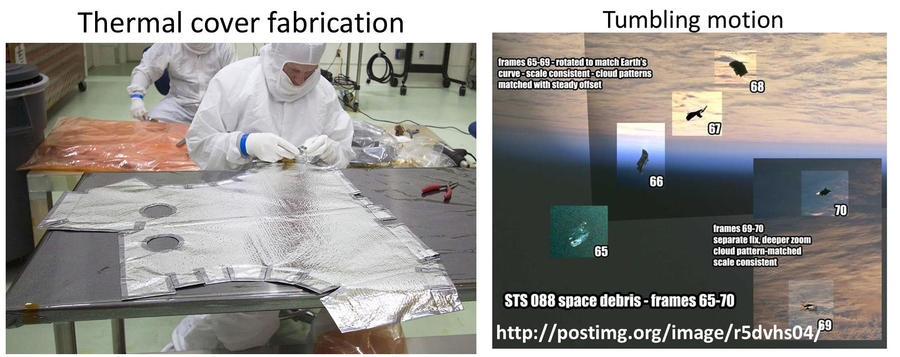
Does photographic evidence and reports from several independent sources, including NASA, show that an ancient satellite has been orbiting Earth since at least the 1950s? No, that's not true: The supposed photographic evidence from NASA, sometimes used to support this myth, does not show an ancient satellite but a thermal blanket accidentally dropped during a space walk on the 1998 STS-88 mission. That piece of space debris was tracked until it eventually burned up when it re-entered Earth's atmosphere. The United Kingdom's Armagh Observatory and Planetarium has explained that the Black Knight Satellite is a myth based on a combination of several unrelated stories.
The claim about an ancient satellite appeared in a video (archived here) on TikTok by @emeraldwisdom on May 13, 2024. The post was captioned:
What else is up there? 🤯 #blackknightsatellite #podcastclips #annunaki #billycarsonofficial #space #satellite #secret #conspiracytiktok #mystery
This is what the post looked like on TikTok at the time of writing:
(Source: TikTok screenshot taken on Fri May 24 15:30:04 2024 UTC)
Two seconds into the video, the narrator introduces the Black Knight Satellite with an image from space (pictured below left). The image is a blurry detail from a high-resolution NASA photo found on the eol.jsc.nasa.gov website (below right). The photo was taken on December 11, 1998, on the Space Shuttle Endeavour STS-88 Space Station Assembly Mission.
The video's narrator, @emeraldwisdom, says:
I believe that this thing is watching us, the Black Knight Satellite. There's this object orbiting Earth that is estimated to be there for 13,000 years, and how we get this number is, NSA analyzed a signal from it, a couple of astrophysicists analyzed the signal, and some ham radio operators back in the 50s also got the same signal. All independent. Came up with the same translation decoding of the signal that it was saying that it was from the Epsilon Bootis Constellation.
(Source: Lead Stories composite image with TikTok and eol.jsc.nasa.gov screenshots taken on Fri May 24 20:35:44 2024 UTC)
The details of the above photo are not in question: They are not part of a 13,000-year-old satellite.
Audio transcripts, video footage and still photographs (here and here) document the accidental untethering of a thermal cover from astronaut Jerry Ross during his 1998 spacewalk as part of the STS-88 mission.
North American Aerospace Defense Command, or NORAD, the U.S.-Canadian agency that monitors the North American continent's air space, tracked and catalogued the thermal cover as International Space Station debris. Identified as "object #S025570" (pictured below), the cover re-entered the atmosphere on December 14, 1998.

(Source: Highlighted Wayback Machine screenshot of data from GCAT [J. McDowell, planet4589.org/space/gcat] taken on Fri May 24 22:01:08 2024 UTC)
Astronaut Jerry Ross' comments about the tether mishap during his spacewalk are recorded in a December 15, 1998, "Up To The Minute" transcript from CBS News:
During the first two spacewalks, Ross lost a socket fitting, a thermal blanket and an access panel cover that somehow slipped free of their safety tethers. He told an interviewer tonight he has no idea how the hardware got away. Asked what his advice might be to fellow spacewalkers, he said: 'Don't do what I did!'
'I don't have the slightest idea what happened,' he said. 'I did four previous spacewalks, never lost an item. I tried to train very hard to do the proper tether protocols to make sure that nothing comes loose in the water tank at home. I thought I'd done all the proper things here and I have absolutely no explanation for why things came loose.'
Despite the hard work and obvious frustration over the tether problem, Ross said spacewalks give him a chance to reflect on the bigger picture when he has a few moments to enjoy the view.
A 43-page .PDF file from author and former space engineer James Oberg, published on October 21, 2014, takes an in-depth look at the thermal cover that became the focus of the Black Knight space legend. Page 13 of the file pictures a thermal cover being made. The image, seen below, shows the cover's irregular shape. The pliant material used for construction does not resemble that of a satellite.
A composite image of the untethered thermal cover in space (seen below right) shows how the irregularly shaped textile, reflective on one side, had many silhouettes as it tumbled. This same image, taken from page 24 of Oberg's PDF file, can be seen in the video on TikTok.
On page 11, the Oberg file describes the purpose of these thermal covers, which were to be installed during extravehicular activity (EVA), or when an astronaut works outside of a spacecraft:
One of the EVA tasks was installing thermal covers over the four trunnion pins on the Node. These are the stubby poles extending from its sides that had locked into sockets along the wall and keel of the Space Shuttle Orbiter's payload bay during launch to docking. Attached to round 'skid plate'.
Once the node was deployed, the trunnion pins were useless. But as bare metal, they were 'heat leaks' into space. Strapping a blanket over each one would save a lot of power, since now it would not be needed for heating.
(Source: Screenshots from pages 13, 24 in jamesoberg.com/sts88_and-black-knight.pdf taken on Fri May 24 22:25:09 2024 UTC)
On July 18, 2013, the United Kingdom's Armagh Observatory and Planetarium published an extensive article enumerating many of the stories associated with the so-called Black Knight satellite. The article concluded:
So although claims of an ancient 13 000 year old satellite originally from a star in the constellation of Böotes, has reportedly been spotted and photographed by NASA astronauts as it travels in polar orbit; in reality this is not the case. Black Knight is a jumble of completely unrelated stories; reports of unusual science observations, authors promoting fringe ideas, classified spy satellites and people over-interpreting photos. These ingredients have been chopped up, stirred together and stewed on the internet to one rambling and inconsistent dollop of myth. The Universe is big place, and astronomers are trying to find signs of other life, some have even searched for alien probes near Earth; however the Black Knight satellite is not the answer and it never has been.
Additional Lead Stories fact checks of claims about satellites and space missions can be found here and here.


















